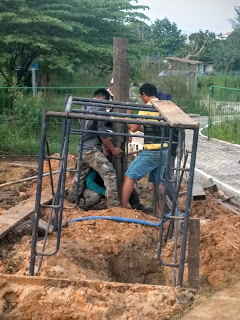Have you ever wondered how pilings were driven into the ground without large construction machinery?
I saw the workers driving some 3m pilings into the ground for a temporary structure a few weeks agi and I thought it was interesting.
Basically, they dig as far as they can easily dig, drop the piling into the hole, and then do various techniques to slam it downwards depending on the current height. It is a relatively slow process, but if you only have a few pilings to drive, it isn’t too bad. This was particularly helpful here because we’ve mostly built out our land and this structure was an afterthought, so access with heavy equipment is limited.
I didn’t see it when they first dropped the pilings into the holes, but later steps involved putting a steel head over the cement piling and then banging it down with a large wooden beam. When the piling was about a meter or so above the ground, they secured a wooden beam across the top of the piling and 4 or 5 workers jumped up and down in sync as they called time. It was interesting to see. Didn’t get a picture though.
The picture above was after the top of the piling was below the level of the ground. They picked up a big wooden beam and used it as a giant hammer on the piling. Lift… drop. Lift… drop.
One of the holes hit a large coconut tree root.
Getting this root out was harder and took longer than driving all of the pilings combined. It involved a combination of digging, sawing, hacking, and winching for about 2 days until they could finally lift the bulk of it out and drive the last piling.
Sometimes I think that we get so addicted to excavators and tractors and pile drivers and the like, it is easy to forget how recent these technologies are in the history of construction. But while the tools might have changed, the process really isn’t all that different from before the age of machinery.
All of the permanent structures on our land used a large excavator to push in a 6-8m long piling. But it is nice to know that the knowledge of the older ways of construction is still kept alive among the workers and their community.
(Although I still hope that they are supported with the appropriate heavy machinery on most of the jobs that they are hired to do. That machinery was invented for a reason.)


